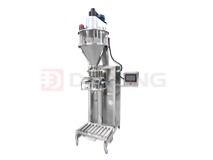The linear vibrating screen uses vibration motor excitation as the source of vibration power, so that the material is thrown up on the screen and moves forward in a straight line. Due to the different working principles of the linear vibrating screen, the materials suitable for screening are also different from other equipment.
.jpg)
The linear vibrating screen is driven by dual vibrators. When the two vibrators rotate synchronously and in opposite directions, the excitation forces generated by their eccentric blocks cancel each other out in the direction parallel to the motor axis, and in the direction perpendicular to the motor axis The superposition is the resultant force, so the motion trajectory of the screen machine is a straight line. The material enters the feed port of the screening machine evenly from the feeder, and passes through the multi-layer screen to produce several specifications of oversize and undersize materials, which are discharged from their respective outlets.
Linear vibrating screens are mainly applicable to industries: screening and classifying powdery and granular materials. They are widely used in plastics, abrasives, chemicals, medicine, building materials, grain, carbon, fertilizers and other industries.
Linear vibrating screens have the characteristics of high screening accuracy, simple structure, easy maintenance, low energy consumption, low noise, good sealing, reduced dust pollution, and long screen life.





 (Live chat)
(Live chat)


_213x160.jpg)


 +86-15136770681
+86-15136770681 sale@vibratingscreen.cc
sale@vibratingscreen.cc +86-373-3669006
+86-373-3669006 From West Room 5, 1st Floor, Building 18, Huilong Yangguang Mingyuan, New District, Xinxiang, Henan, China (Mainland).
From West Room 5, 1st Floor, Building 18, Huilong Yangguang Mingyuan, New District, Xinxiang, Henan, China (Mainland). Your Position:
Your Position:.jpg)



